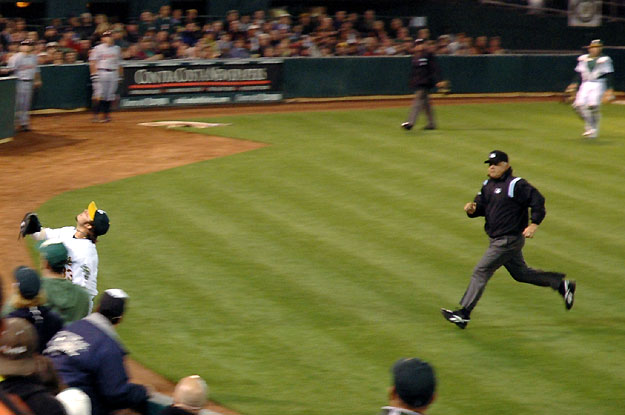2006 Photo Outtakes #34
2007-01-23 1:10

Continuing the popup theme…it’s a pretty neat trick to get everyone in this picture except Nick Swisher and the umpire completely out of focus. I wish I knew how I did that.

Continuing the popup theme…it’s a pretty neat trick to get everyone in this picture except Nick Swisher and the umpire completely out of focus. I wish I knew how I did that.

1. Yeah it kind of looks like a photoshop job. Though why people would photoshop running umpires into random photos is a question without an answer.
2. Maybe you've said this before, but what kind of camera do you use? You take really great pictures.
Also, any tips for taking good baseball photos. If you want to drop some mad F/stop knowledge on us, it would be appreciated.
3. 2 Nikon D70, standard lens. In the daytime, I just use the Auto setting, and it works great.
I have a lot more trouble during night games. If I leave the shutter open long enough to let light in, the moving players get blurry, and if I do a quick shutter, the picture is often too dark. This picture above is part of my night-game struggles; I still haven't figured out the optimal settings yet. Right now, I lean towards taking the picture too dark, and letting Photoshop brighten it up afterwards. But then, the picture looks somewhat grainy.
4. This is an especially remarkable photo in that the umpire is clearly moving quickly, relative to the frame. However, I think I can explain:
Had you been using a fully manual camera, you'd be doing three things to get the image right:
Focus: you'd focus on Swisher. The umpire appears to be at around the same focal depth, so you accidentally get the ump in focus too.
Shutter speed: you'd push this as fast as possible to reduce the blur on fast-moving objects. So the ump is not so blurry because a fast shutter speed was probably used.
Aperture: you'd open the aperture wide to allow more light in (compensating for the low light conditions and the faster shutter speed). The consequence of a wide aperture is that the focal depth shortens, so only those things in a similar depth as the main focus point will be in focus, and everything else blurs. Under similar lighting conditions but a completely still setting, you could get more things in focus by having a slower shutter speed but a narrower aperture.
If you wanted to get more things in focus in these circumstances, however, you'd need more light or a faster film speed -- did I say film? He he.
5. How I do it: I use a Canon 20D, now out of production, but the best thing available for this kind of photography short of the 1D they use in the photographer's pits. Day settings you can use full auto, mostly; nighttime rules:
1) Turn your camera to its manual, aperture-fixed mode, and open your lens as wide as it will go.
2) Turn the ISO-equivalent on your camera to as high a number as it will support (this will by 1600 for this camera).
3) Remember your camera will need a ton more stability at night than in the daytime. If you can swing it, use a monopod. (They won't let you take one into some of the stadiums I've been to lately.)
Not that it's perfect, but it does turn out some decent shots:
http://www.doubledogmusic.com/baseball/2006-09-18_Padres@Dodgers/50.html
http://www.doubledogmusic.com/baseball/2006-09-18_Padres@Dodgers/51.html
6. 4,5 thanks for the tips, guys.
I think much of my problem is that there are so many buttons and switches and dials on the camera, I have a hard time figuring out how to do things like turn off the flash, or change the ISO setting, or adjust the aperture. I need my manual to figure those things out, and I usually don't take it with me to the ballgame, so I just end up going, "maybe next time" and then I get home and forget.
7. This is why I always carry my camera in a camera bag, and keep the docs there.
8. 8 Yeah, but then (a) I'd have to subject myself to the stadium entrance bag search instead of just walking right in, and (b) I'm certain one of these days I'd end up going home without the camera bag. I kinda have the absent-minded professor thing going for me at times. If the camera is either in my hand or around my neck at all times, I can't leave without it.